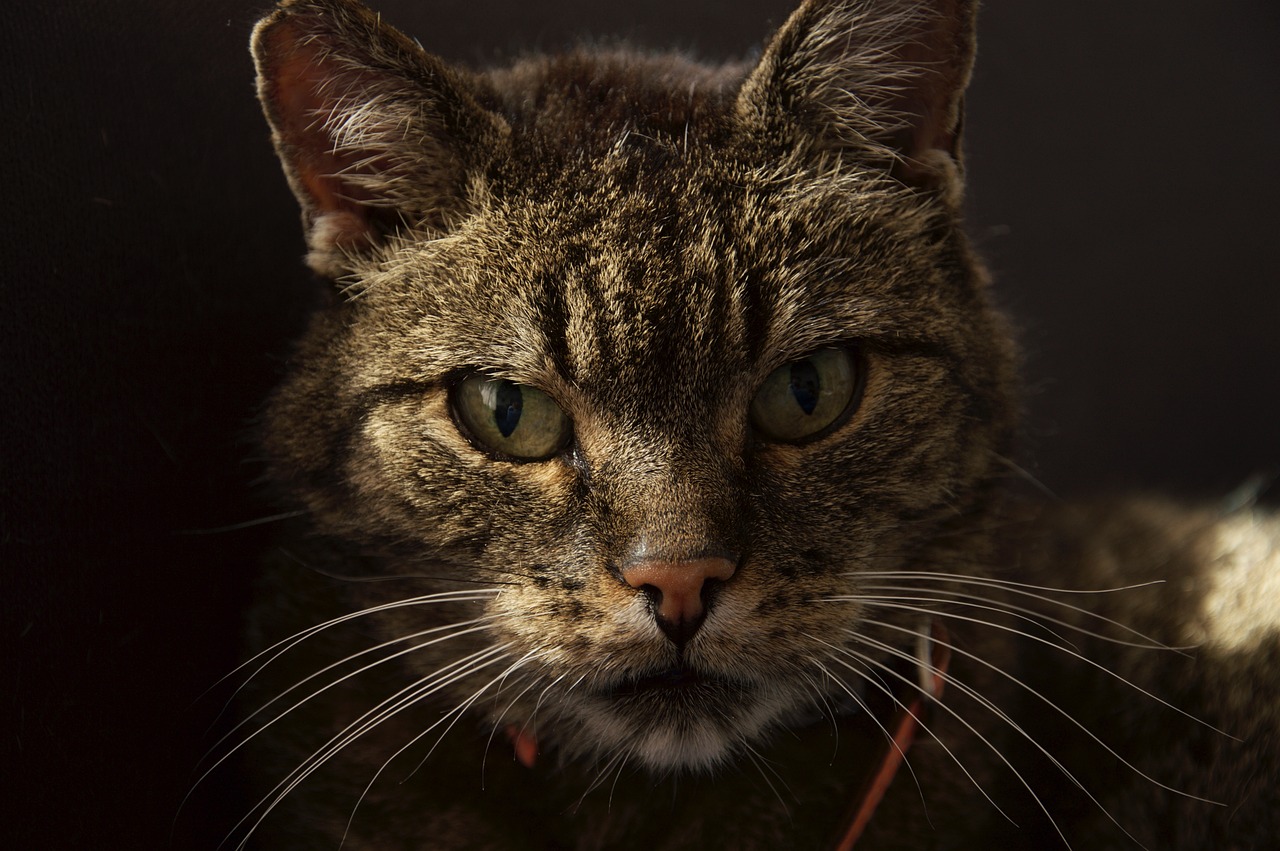How to Create a Calming Environment for Pets
Creating a calming environment for your pets is not just a luxury; it's a necessity. Just like us, our furry friends experience stress and anxiety, and their surroundings play a pivotal role in their overall well-being. Imagine coming home after a long day to a place that feels like a sanctuary. Wouldn't that be comforting? Your pets deserve that same feeling! In this article, we will explore effective strategies to enhance your pet's living space, ensuring they feel safe, relaxed, and happy.
First and foremost, understanding the needs of your pet is crucial. Different animals have different stress triggers. For instance, a dog might get anxious with loud noises, while a cat may feel threatened by unfamiliar scents. By recognizing these unique traits, you can tailor your home environment to cater to their specific needs. Think of your home as a canvas; with the right brushstrokes, you can create a masterpiece that brings peace and tranquility to your pet's life.
Moreover, the atmosphere you create extends beyond just physical space. It's about fostering an ambiance that promotes relaxation. This includes everything from the colors you choose for your decor to the scents that linger in the air. Soft, muted colors can evoke feelings of calm, while essential oils like lavender can soothe frayed nerves. The key is to create a space that not only looks good but feels good too. So, let’s dive deeper into how you can achieve this.
Recognizing the signs of anxiety in pets is crucial for creating a calming environment. Pets, just like humans, can exhibit various behaviors when they're feeling stressed. Common indicators include excessive barking, hiding, destructive behavior, and changes in eating or sleeping patterns. Understanding these signs is the first step in addressing their needs. But what causes this anxiety? It can stem from a variety of sources such as loud noises, changes in routine, or even the presence of unfamiliar animals. By identifying these triggers, you can start to create a more peaceful environment for your beloved companions.
The environment plays a significant role in a pet's comfort. Choosing the right space in your home is essential for promoting tranquility and security for your furry friends. Think about areas that are quiet and away from the hustle and bustle of daily life. For example, a cozy corner in your living room or a serene spot in your bedroom can serve as a perfect retreat. The right space should be easily accessible to your pet and should feel safe and inviting. You want them to feel like they have their own little haven where they can unwind and relax.
Designating quiet areas in your home can help pets feel safe. These zones are essential for pets that may be skittish or easily startled by noise. Consider creating a small nook with their favorite blanket, toys, and perhaps even a calming diffuser. The goal is to make this space inviting and comforting. A well-structured quiet zone can serve as a retreat where your pets can escape the chaos of the outside world. Remember, just like we all need a quiet space to recharge, so do our pets!
Implementing soundproofing methods can minimize noise-related stress. Here are some effective strategies:
- Use heavy curtains to block out external noise.
- Seal gaps in windows and doors to prevent sound leakage.
- Consider adding rugs or carpets to absorb sound.
These techniques can significantly reduce the disturbances that may frighten your pets, allowing them to feel more secure in their environment.
Providing cozy bedding contributes to a calming space. Think of it as creating a nest for your pet. Options like soft fleece blankets, cushioned beds, or even heated mats can enhance your pet's comfort and relaxation. A well-chosen bed can make a world of difference, giving your furry friend a place to curl up and feel safe. Remember, a happy pet is a comfortable pet!
Incorporating calming elements can significantly reduce anxiety. This can include items such as:
- Calming music or white noise machines to drown out sudden sounds.
- Familiar toys or blankets that carry their scent.
- Plants like catnip or lavender, which can have a calming effect.
These elements help create a serene environment, making your home a peaceful retreat for your pets.
Various products are available to help soothe pets. From calming sprays to diffusers, these tools can promote relaxation in a big way. Many of these products contain natural ingredients that can help calm anxious pets. For example, pheromone diffusers mimic the calming scents that pets recognize from their mothers. This can create a sense of security and comfort in their environment.
Natural remedies can also be beneficial for anxious pets. Herbal options such as chamomile and valerian root are known for their calming properties. You might also consider holistic approaches like acupuncture or massage therapy, which can help alleviate stress. Always consult with your veterinarian before introducing new remedies to ensure they are safe for your pet.
Sometimes, professional assistance is necessary. If your pet's anxiety persists despite your best efforts, it may be time to seek help from veterinarians or animal behaviorists. They can provide tailored advice and treatment plans that can significantly improve your pet's quality of life. Remember, there’s no shame in seeking help—your pet's well-being is worth it!
Q: How can I tell if my pet is anxious?
A: Look for signs such as excessive barking, hiding, destructive behavior, or changes in appetite or sleep patterns.
Q: What are some quick ways to calm my pet during a storm?
A: Create a safe space with their favorite blanket, use calming sprays, and play soothing music to help them relax.
Q: Are there any natural remedies for pet anxiety?
A: Yes, herbal options like chamomile and valerian root can be effective. Always consult with your vet before trying new remedies.
Q: When should I seek professional help for my pet?
A: If your pet's anxiety persists despite your efforts, or if it severely impacts their quality of life, it's time to consult a professional.

Understanding Pet Anxiety
Recognizing the signs of anxiety in pets is crucial for creating a calming environment. Just like humans, our furry companions can experience stress and anxiety, which can manifest in various behavioral indicators. Have you ever noticed your dog pacing back and forth or your cat hiding under the bed? These behaviors are not just quirks; they can be red flags signaling that your pet is feeling anxious.
Common signs of anxiety in pets include:
- Excessive barking or meowing: This can be a cry for help, indicating that your pet is feeling overwhelmed.
- Destructive behavior: Chewing furniture or clawing at doors is often a sign of frustration and stress.
- Increased aggression: A normally docile pet may lash out when feeling threatened or scared.
- Withdrawal: If your pet suddenly becomes reclusive, it might be their way of coping with anxiety.
- Changes in appetite: Stress can lead to overeating or loss of appetite, both of which are concerning.
Understanding these signs is just the first step. To truly address your pet's anxiety, it's essential to delve into the underlying causes. Factors such as loud noises, changes in routine, or even the presence of unfamiliar people or animals can trigger anxiety in pets. For instance, many dogs are sensitive to thunderstorms or fireworks, which can send them into a panic. Similarly, changes in the household, like moving to a new home or the arrival of a new family member, can upset their sense of security.
Moreover, some pets may have a genetic predisposition to anxiety. Breeds like Border Collies and Chihuahuas are known to be more prone to anxiety-related issues. Understanding your pet's breed and individual personality can help you tailor your approach to their specific needs.
Creating a calming environment requires a keen awareness of these signs and triggers. By being vigilant and proactive, you can help your furry friend navigate their anxiety and foster a sense of peace in their surroundings. Remember, just as we seek comfort and security in our homes, our pets deserve the same. So, let's dive deeper into how we can create that tranquil space for them!

Choosing the Right Space
When it comes to creating a calming environment for your beloved pets, the space they inhabit plays a pivotal role. Just like humans, pets thrive in environments that provide them with a sense of safety and comfort. Imagine your pet’s living area as their personal sanctuary—a place where they can unwind and recharge after a long day of play. The right space can significantly reduce anxiety and promote overall well-being. So, how do you choose and arrange these spaces to ensure your furry friends feel secure?
First and foremost, it’s essential to consider the layout of your home. Look for areas that are naturally quieter and less chaotic. This might mean moving their bed away from high-traffic zones or loud appliances. Think of it this way: would you want to sleep next to a busy road? Probably not! Similarly, your pets will appreciate a peaceful retreat away from the hustle and bustle of daily life.
Next, let’s talk about lighting. Soft, warm lighting can create a cozy atmosphere that helps pets feel more relaxed. Avoid harsh fluorescent lights that can be jarring. Instead, consider using lamps or even fairy lights to create a soothing ambiance. If your pet enjoys basking in the sun, make sure to provide a space near a window where they can soak up those warm rays while feeling safe indoors.
Another critical factor is the furniture arrangement. Ensure that your pet has easy access to their favorite spots without obstacles. For example, if your dog loves to lounge on the couch, make sure it’s easily accessible. You might even want to create a little nook or corner specifically for them, complete with their favorite toys and a cozy blanket. This designated area will serve as their personal retreat, reinforcing the idea that they have a safe space to call their own.
Moreover, consider the temperature of the space. Pets can be sensitive to extreme temperatures, so it’s essential to maintain a comfortable climate. During the hot summer months, ensure they have a cool spot to relax, perhaps with a fan or air conditioning. In the winter, provide warm bedding and consider placing their bed in a draft-free area. Your pets will thank you for it!
Finally, don’t forget about the visuals. A cluttered space can lead to stress for both pets and humans. Keep their area tidy and free from unnecessary distractions. You might also want to incorporate natural elements, like plants (that are safe for pets), to create a more serene environment. Just remember, a little greenery can go a long way in making the space feel more inviting and calming.
In summary, choosing the right space for your pets involves a thoughtful combination of layout, lighting, furniture arrangement, temperature control, and aesthetics. By creating a designated area that caters to their needs, you can significantly enhance their comfort and reduce anxiety. After all, a happy pet means a happy home!
Quiet Zones
Creating in your home is a vital step in ensuring your pets feel safe and secure. Just like us, pets need their own little sanctuary where they can retreat and unwind from the hustle and bustle of daily life. Imagine how you feel after a long day—sometimes, all you need is a cozy corner to recharge. Your furry friends are no different! By designating specific areas in your home as quiet zones, you provide them with a refuge that promotes relaxation and reduces stress.
When setting up these tranquil spaces, consider locations that are away from the main traffic areas of your home. This could be a quiet corner of a room, a cozy nook under the stairs, or even a dedicated space in your bedroom. The key is to ensure that these zones are free from noise and distractions. For example, if your living room is often bustling with family activities or loud TV shows, it might not be the best place for your pet to relax. Instead, think about creating a serene spot in a less frequented area of the house.
To enhance these quiet zones, you can incorporate calming elements such as soft lighting, comfortable bedding, and even some soothing scents. A simple setup could include:
- **Soft, plush bedding**: This encourages your pet to snuggle in and feel secure.
- **Calming music or white noise**: Gentle sounds can drown out sudden noises that might startle your pet.
- **A few favorite toys**: Familiar items can provide comfort and a sense of security.
Additionally, it’s essential to keep these zones clean and inviting. Regularly wash the bedding and keep the area free of clutter. You want your pet to associate these spaces with peace and comfort, not chaos. Remember, a well-designed quiet zone can be a game-changer for your pet's emotional well-being.
Ultimately, the goal is to create an environment where your pet can feel safe and relaxed. By paying attention to their needs and preferences, you can ensure that your home is a haven for your beloved companions. So, take a moment to evaluate your living space—are there areas that could be transformed into a quiet zone? Your pets will thank you!
Soundproofing Techniques
When it comes to creating a calming environment for your pets, one of the most effective strategies is implementing . Just like us, our furry friends can be easily startled or stressed by loud noises, whether it's the sound of traffic, construction, or even the neighbor's barking dog. So, how can we shield them from these disturbances? Let's explore some practical methods to reduce noise and create a peaceful haven for your pets.
First off, consider using heavy curtains or sound-absorbing drapes. These not only block out light but also help to muffle sounds coming from outside. Opt for thick, plush fabrics that can absorb sound waves effectively. Additionally, if you have windows that allow a lot of noise in, installing double-glazed windows can significantly reduce the sound that penetrates your home.
Another effective technique is to utilize acoustic panels. These panels can be strategically placed on walls to dampen sound and prevent echoes. You can either purchase pre-made panels or create your own using materials like foam or fabric-covered boards. By covering bare walls, you can create a more serene environment that feels less chaotic for your pets.
It’s also essential to consider the flooring in your home. Hard surfaces like tile or hardwood can amplify noise, making your home feel less tranquil. If possible, add rugs or carpets to absorb sound and provide a softer landing for your pets. Not only does this help with noise reduction, but it also adds an extra layer of comfort for your furry friends when they lounge around.
Lastly, if your pet is particularly sensitive to noise, you might want to create a designated quiet zone in your home. This could be a small room or a cozy corner filled with their favorite blankets and toys. In this space, you can use soundproofing techniques like placing a heavy door mat to further minimize noise from outside. Make sure this area is away from high-traffic zones where sounds are more likely to disrupt their peace.
By incorporating these soundproofing techniques, you can significantly enhance your pet's environment, helping them feel safer and more relaxed. Remember, the goal is to create a sanctuary where your pets can escape the chaos of the outside world. Every little adjustment counts, and your furry friends will surely appreciate the effort!
- What are the signs that my pet is stressed? Look for behaviors such as excessive barking, hiding, or changes in eating habits.
- How can I tell if my soundproofing techniques are working? If your pet seems calmer and less reactive to outside noises, your methods are likely effective.
- Are there specific materials that work best for soundproofing? Yes, materials like heavy curtains, acoustic panels, and carpets are particularly effective.
Comfortable Bedding Options
When it comes to creating a calming environment for your pets, one of the most important aspects is their bedding. Just like us, our furry friends need a cozy and inviting spot to relax and recharge. Think of it as their personal sanctuary—a place where they can snuggle up and feel safe. So, what should you consider when choosing the right bedding? Let’s dive into some fantastic options that can turn your pet's sleeping area into a haven of comfort.
First off, consider the material. Soft, breathable fabrics like cotton or microfiber are excellent choices. They not only provide a plush surface but also help regulate your pet's temperature, keeping them cool in the summer and warm in the winter. You might also want to look into memory foam beds, which offer superior support, especially for older pets or those with joint issues. These beds contour to your pet's body, providing the perfect level of comfort. Imagine sinking into a cloud after a long day—your pet deserves that too!
Next, think about the size. A bed that’s too small can make your pet feel cramped and anxious, while one that’s too large can be overwhelming. Measure your pet while they’re lying down to ensure you choose a bed that fits them just right. For multi-pet households, consider getting beds in various sizes or even a large communal bed where they can snuggle together. It's like having a cozy sleepover every night!
Now, let’s talk about the shape. Round beds are perfect for pets that love to curl up, creating a den-like atmosphere, while rectangular beds provide more space for those who prefer to stretch out. Additionally, look for beds with raised edges or bolsters. These can give your pet a sense of security, almost like a comforting hug. Think of it as a warm embrace that helps them drift off into dreamland.
Don’t forget about washability. Pets can be messy, and having a bed that’s easy to clean is essential. Look for removable covers that can be tossed in the washing machine. This not only keeps the bed fresh but also helps reduce allergens in your home. After all, a clean bed means a happy pet!
Lastly, consider adding a few personal touches to your pet’s bedding area. A soft blanket or a favorite toy can make their space feel even more inviting. You might even want to sprinkle a bit of your scent on their bedding—it's like leaving a little piece of you with them when you're not around. This can be incredibly soothing for pets who experience separation anxiety.
In summary, selecting the right bedding for your pet is all about comfort, support, and a sense of security. By investing in quality bedding, you’re not just enhancing their physical comfort; you’re also contributing to their overall well-being. A happy pet means a happy home!
- What type of bedding is best for my dog?
Soft, breathable materials like cotton or microfiber are ideal. Memory foam beds are great for older dogs or those with joint issues. - How often should I wash my pet's bedding?
It’s best to wash your pet's bedding at least once a month, or more frequently if they are prone to accidents or shedding. - Can I use human bedding for my pets?
While human bedding can be used, it’s better to choose bedding specifically designed for pets, as they are often more durable and easier to clean. - Do pets prefer beds with or without sides?
It depends on the pet. Some pets feel more secure in beds with sides, while others prefer the freedom of an open bed.
Soothing Elements
Creating a calming environment for your pets goes beyond just choosing the right space; it’s about incorporating that can significantly reduce anxiety levels. Think of your pet’s space as a sanctuary, a place where they can feel safe and relaxed. One of the most effective ways to achieve this is by introducing a variety of calming components into their environment. For instance, consider using soft lighting. Harsh, bright lights can create a sense of unease, while soft, warm lighting can mimic the natural ambiance of a cozy den. This simple change can help put your pet at ease.
Another essential element is the use of aromatic diffusers. Scents such as lavender and chamomile are known for their calming properties. You can place a diffuser in your pet’s area to fill the space with these soothing scents. However, it’s important to ensure that any essential oils used are safe for pets, as some can be harmful. Always do your research or consult with a veterinarian before introducing new scents into your home.
Additionally, consider incorporating natural elements into your pet's environment. Plants like catnip for cats or valerian root for dogs can provide a calming effect. Just be sure to choose pet-safe plants and keep harmful varieties out of reach. You can also create a small indoor garden or a dedicated corner with these plants, which not only beautifies the space but also offers a sensory experience for your furry friends.
Moreover, the use of soft textures can greatly enhance your pet's comfort. Providing plush blankets or soft rugs can create a cozy atmosphere that encourages relaxation. Imagine your pet curling up on a fluffy rug, feeling secure and warm – it’s a simple yet effective way to promote tranquility. You might also want to consider pet-friendly furniture that allows them to lounge comfortably while feeling safe and supported.
Lastly, incorporating gentle sounds can also help soothe your pets. Consider playing soft music or using a white noise machine to drown out sudden, startling noises from outside. This can create a serene backdrop that helps mask any jarring sounds that might otherwise cause anxiety. Think of it as creating a sound blanket that wraps your pet in a cocoon of comfort.
In summary, by focusing on these soothing elements—soft lighting, calming scents, natural features, plush textures, and gentle sounds—you can create a truly serene environment for your pets. It’s all about making small adjustments that can lead to a big difference in their overall well-being.

Utilizing Calming Products
When it comes to creating a soothing environment for our furry friends, calming products can be game-changers. These products are designed specifically to help alleviate anxiety and promote relaxation in pets. Just like humans benefit from a warm cup of tea or a cozy blanket after a long day, pets too can find comfort in specially formulated items. So, let’s dive into some of the most effective calming products available and how they can transform your pet's living space into a serene haven.
First on the list are calming sprays. These sprays typically contain natural ingredients like lavender or chamomile, known for their soothing properties. Simply spritz a bit on your pet’s bedding or in their favorite lounging area, and watch as they settle down into a state of bliss. It’s like giving your pet a gentle hug in the form of a mist! However, it's essential to ensure that the ingredients are safe for your specific type of pet, as some animals may be sensitive to certain scents.
Next, we have diffusers. These devices release calming pheromones into the air, which can significantly help reduce anxiety levels. Imagine walking into a room filled with a soft, relaxing aroma that instantly puts you at ease; that's the effect a diffuser can have on your pet. Place it in their main living area or bedroom, and let the calming scents work their magic. Just remember to keep the diffuser out of reach to prevent any accidental spills or curious snouts getting too close.
Another popular option is calming collars. These collars are infused with pheromones or essential oils that help soothe pets throughout the day. They’re a fantastic choice for pets that experience anxiety during travel or when left alone at home. It’s like wearing a comforting blanket that travels with them wherever they go! Just make sure to follow the manufacturer's instructions regarding size and duration of use to ensure maximum effectiveness.
For those looking for a more hands-on approach, consider using calming chews. These treats often contain ingredients like valerian root or L-theanine, which are known to promote relaxation. Giving your pet a calming chew before stressful events, like thunderstorms or vet visits, can help ease their nerves. Think of it as a little pre-game snack that helps them stay cool and collected!
While these products can be incredibly effective, it’s crucial to remember that they work best when combined with other calming strategies. Creating a peaceful environment with soft lighting, comfortable bedding, and quiet zones is equally important. By integrating calming products with a well-thought-out living space, you can create a sanctuary for your pet that minimizes anxiety and maximizes comfort.
In summary, utilizing calming products can significantly enhance your pet's quality of life. Whether it’s through sprays, diffusers, collars, or chews, these tools can help your furry friend feel more at ease in their environment. However, if you find that your pet's anxiety persists despite these efforts, it might be time to consult with a professional. Remember, every pet is unique, and finding the right combination of calming techniques may take some experimentation.
- What are calming products for pets? Calming products are specially formulated items designed to alleviate anxiety and promote relaxation in pets. They include sprays, diffusers, collars, and treats.
- Are calming sprays safe for all pets? While many calming sprays are safe, it’s essential to check the ingredients and ensure they are suitable for your specific type of pet.
- How long does it take for calming products to work? The effectiveness of calming products can vary. Some may work immediately, while others may take a few days of consistent use to see results.
- Can I use multiple calming products at once? Yes, combining different calming products can be effective. However, monitor your pet for any adverse reactions.
- When should I seek professional help for my pet's anxiety? If your pet’s anxiety persists despite using calming products and environmental adjustments, it may be time to consult a veterinarian or animal behaviorist.
Natural Remedies
When it comes to easing your pet's anxiety, can be a fantastic option. Just like humans, pets can benefit from the soothing properties of certain herbs and holistic approaches. Imagine your furry friend curling up in a cozy spot, feeling relaxed and at ease—sounds perfect, right? Let's explore some of the most effective natural remedies that can help calm your pet's nerves.
One of the most popular natural remedies is lavender. This fragrant herb is known for its calming properties, not just for people but for pets too! You can use lavender essential oil in a diffuser or even apply it to your pet's bedding (make sure to dilute it properly). The soothing scent can help create a peaceful atmosphere, allowing your pet to unwind. However, always consult with a veterinarian before introducing any new substances to your pet's environment.
Another great option is chamomile. This herb is often used in teas for its relaxing effects, and it can also be beneficial for pets. You can prepare chamomile tea and let it cool down before offering it to your pet as a treat. Just a small amount can help soothe their nerves. Additionally, chamomile can be found in various calming products specifically designed for pets, making it easier to incorporate into their routine.
CBD oil has gained popularity in recent years as a natural remedy for anxiety in pets. Derived from hemp, CBD oil is non-psychoactive and can help reduce stress and promote relaxation. Many pet owners have reported positive results, but it’s crucial to choose high-quality products and consult with your vet to determine the right dosage for your furry friend.
Moreover, you can also consider valerian root, which is another herb known for its calming effects. It works similarly to chamomile and can be found in various forms, including capsules and tinctures. Just like with any supplement, it's essential to check with your veterinarian before starting your pet on valerian root.
Lastly, don't underestimate the power of environmental enrichment. Sometimes, a little distraction can go a long way in alleviating anxiety. Providing engaging toys, puzzle feeders, or even creating a safe space with their favorite blankets can help keep your pet occupied and reduce their stress levels. Creating a stimulating yet calming environment can be the key to your pet's happiness.
In summary, natural remedies can be a gentle and effective way to help manage your pet's anxiety. Whether you choose lavender, chamomile, CBD oil, or valerian root, always remember to consult with your veterinarian to ensure the best approach for your beloved companion. With the right combination of calming elements and natural remedies, you can create a serene atmosphere that promotes relaxation and well-being for your furry friend.
- What are the signs of anxiety in pets? Look for behaviors such as excessive barking, hiding, destructive chewing, or changes in eating habits.
- Can I use human calming products on my pets? It's best to avoid using human products unless specifically designed for pets, as some ingredients can be harmful.
- How long does it take for natural remedies to work? The effectiveness of natural remedies can vary, but many pet owners notice improvements within a few days to weeks.
- Should I consult a vet before trying natural remedies? Yes, it's always a good idea to consult with a veterinarian before introducing any new treatments to ensure they are safe for your pet.
Professional Help
Sometimes, despite our best efforts, we may find that our furry friends are still struggling with anxiety. It can be heartbreaking to watch a pet suffer, especially when all they want is to feel safe and secure. This is where seeking becomes a vital step in ensuring your pet's well-being. But how do you know when it's time to reach out for assistance? Well, if you notice persistent signs of anxiety—such as excessive barking, destructive behavior, or withdrawal from social interactions—it’s a good indication that professional guidance may be necessary.
Veterinarians and animal behaviorists are trained to understand the complexities of pet behavior and can offer tailored advice that aligns with your pet's unique needs. They can help identify underlying issues that may be contributing to your pet's anxiety, such as medical conditions or past traumas. In some cases, they may recommend behavioral therapy, which can be incredibly effective in teaching your pet new coping strategies.
Moreover, it’s essential to recognize that every pet is different. What works for one might not work for another. Therefore, a professional can help devise a comprehensive plan that could include:
- Behavioral Modification Techniques: These are strategies designed to change your pet's behavior through positive reinforcement and desensitization.
- Medication: In some cases, anti-anxiety medications may be prescribed to help manage your pet's symptoms while you work on behavioral changes.
- Environmental Adjustments: Professionals can offer insights on how to modify your home environment to better suit your pet's needs.
Don't hesitate to seek help if you feel overwhelmed. Remember, it’s not just about fixing a problem; it’s about enhancing your pet's quality of life. By collaborating with professionals, you can create a more peaceful and loving environment that fosters your pet's happiness and security.
Q: How do I know if my pet is anxious?
A: Signs of anxiety can include excessive barking, destructive behavior, hiding, or changes in eating habits. If you notice these behaviors, it may be time to consult a professional.
Q: What should I expect during a consultation with a veterinarian or animal behaviorist?
A: They will typically conduct a thorough assessment of your pet's behavior and health history, followed by recommendations for treatment options tailored to your pet's specific needs.
Q: Are there natural remedies for pet anxiety?
A: Yes! Many pet owners find success with natural remedies such as herbal supplements or calming sprays. However, it’s always best to discuss these options with a professional to ensure they are safe for your pet.
Q: How long does it take to see improvement in my pet's anxiety?
A: The timeline for improvement can vary widely depending on the individual pet and the methods used. Some pets may show improvement within weeks, while others may take longer. Consistency and patience are key!
Frequently Asked Questions
- What are the common signs of anxiety in pets?
Pets can exhibit various signs of anxiety, such as excessive barking, hiding, destructive behavior, or changes in eating habits. If you notice your furry friend acting unusually, it might be a sign they are feeling stressed or anxious.
- How can I create a calming space for my pet?
To create a calming environment, designate quiet zones in your home where your pet can retreat. Use comfortable bedding, minimize noise, and consider adding soothing elements like soft lighting or calming scents to enhance their comfort.
- Are there specific products that can help soothe my pet?
Yes! There are several calming products available, including sprays, diffusers, and calming collars. These products often contain natural ingredients that can help reduce anxiety and promote relaxation in pets.
- What natural remedies are effective for anxious pets?
Natural remedies such as chamomile, lavender, or valerian root can be beneficial for pets experiencing anxiety. Always consult with your veterinarian before introducing any new remedies to ensure they are safe for your furry friend.
- When should I seek professional help for my pet's anxiety?
If your pet's anxiety persists despite your efforts to create a calming environment or if their behavior worsens, it may be time to consult a veterinarian or an animal behaviorist. They can provide tailored advice and treatment options to help your pet feel more at ease.



















